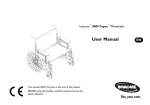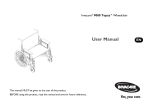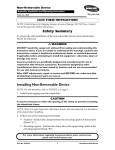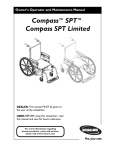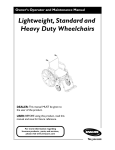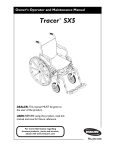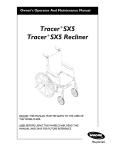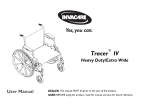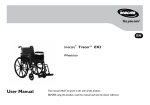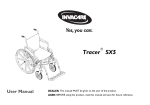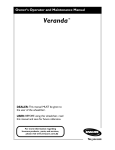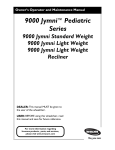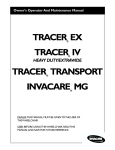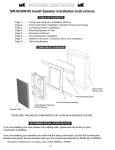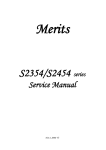Download Topaz User Manual
Transcript
Owner’s Operator and Maintenance Manual 9000 Topaz™Wheelchair DEALER: This manual MUST be given to the user of the wheelchair. USER: BEFORE using this wheelchair, read this manual and save for future reference. For more information regarding Invacare products, parts, and services, please visit www.invacare.com WARNING A QUALIFIED TECHNICIAN MUST PERFORM THE INITIAL SET UP OF THIS WHEELCHAIR. ALSO, A QUALIFIED TECHNICIAN MUST PERFORM ALL PROCEDURES SPECIFICALLY INDICATED IN THE MANUAL. DO NOT USE THIS PRODUCT OR ANY AVAILABLE OPTIONAL EQUIPMENT WITHOUT FIRST COMPLETELY READING AND UNDERSTANDING THESE INSTRUCTIONS AND ANY ADDITIONAL INSTRUCTIONAL MATERIAL SUCH AS OWNER’S MANUALS, SERVICE MANUALS OR INSTRUCTION SHEETS SUPPLIED WITH THIS PRODUCT OR OPTIONAL EQUIPMENT. IF YOU ARE UNABLE TO UNDERSTAND THE WARNINGS, CAUTIONS OR INSTRUCTIONS, CONTACT A HEALTHCARE PROFESSIONAL, DEALER OR TECHNICAL PERSONNEL BEFORE ATTEMPTING TO USE THIS EQUIPMENT - OTHERWISE, INJURY OR DAMAGE MAY OCCUR. ACCESSORIES WARNING Invacare products are specifically designed and manufactured for use in conjunction with Invacare accessories. Accessories designed by other manufacturers have not been tested by Invacare and are not recommended for use with Invacare products. NOTE: Updated versions of this manual are available on www.invacare.com. 9000 Topaz™Wheelchair 2 Part No. 1150770 TABLE OF CONTENTS TABLE OF CONTENTS SPECIAL NOTES ................................................................................ 6 LABEL LOCATION ............................................................................ 7 TYPICAL PRODUCT PARAMETERS .................................................... 8 SECTION 1—GENERAL GUIDELINES ................................................... 9 Operating Information...............................................................................................................................9 Weight Training ........................................................................................................................................10 Weight Limitation.....................................................................................................................................10 Stability........................................................................................................................................................11 Anti-Tippers...............................................................................................................................................11 SECTION 2—SAFETY/HANDLING OF WHEELCHAIRS ......................... 12 Safety/Handling of Wheelchairs.............................................................................................................12 Stability and Balance.................................................................................................................................12 Coping With Everyday Obstacles.........................................................................................................13 A Note to Wheelchair Assistants ........................................................................................................13 Reaching, Leaning and Bending Forward.............................................................................................14 Reaching, Leaning Backwards.................................................................................................................14 Tilting...........................................................................................................................................................14 Stairways.....................................................................................................................................................15 Escalators....................................................................................................................................................15 Transferring To and From Other Seats ..............................................................................................16 Unfolding and Folding Wheelchair .......................................................................................................16 Unfolding Wheelchair .........................................................................................................................16 Folding Wheelchair..............................................................................................................................17 SECTION 3—SAFETY INSPECTION/TROUBLESHOOTING .................... 18 Safety Inspection Checklists...................................................................................................................18 Inspect/Adjust Initially .........................................................................................................................18 Inspect/Adjust Weekly........................................................................................................................19 Inspect/Adjust Monthly.......................................................................................................................19 Inspect/Adjust Periodically.................................................................................................................19 Troubleshooting .........................................................................................................20 Maintenance ...............................................................................................................................................20 SECTION 4—FRONT RIGGINGS ........................................................ 21 Installing/Removing Swingaway Footrest Assembly..........................................................................21 Installing..................................................................................................................................................21 Part No. 1150770 3 9000 Topaz™Wheelchair TABLE OF CONTENTS TABLE OF CONTENTS Removing ...............................................................................................................................................21 Swingaway Footrest Height Adjustment.............................................................................................22 Installing/Removing Elevating Legrest Assembly................................................................................22 Installing..................................................................................................................................................22 Removing ...............................................................................................................................................23 Adjusting Elevating Legrest Assembly..................................................................................................23 Adjusting Footrest Height..................................................................................................................23 Adjusting Calfpad .................................................................................................................................23 Raising Elevating Legrest Assembly..................................................................................................24 Lowering Elevating Legrest Assembly .............................................................................................24 Installing Calf Strap ..............................................................................................................................25 Heel Loop Replacement .....................................................................................................................25 SECTION 5—ARMS ......................................................................... 26 Adjusting Armrest Height.......................................................................................................................26 Replacing Desk/Full Length Armrest Pad............................................................................................27 Removing or Replacing Armrest...........................................................................................................28 Removing Armrests.............................................................................................................................28 Replacing Armrests..............................................................................................................................28 SECTION 6—SEAT AND BACK ......................................................... 29 Replacing Seat Upholstery......................................................................................................................29 Replacing Back Upholstery .....................................................................................................................30 Adjusting Back Height..............................................................................................................................30 Adjusting Seat Depth ...............................................................................................................................31 Adjusting Seat Width...............................................................................................................................31 SECTION 7—REAR WHEELS ............................................................. 32 Removing/Installing Rear Wheels .........................................................................................................32 Replacing/Repairing Rear Wheel Tire/Tube.......................................................................................33 SECTION 8—FRONT CASTERS ......................................................... 34 Installing/Replacing 15.24 x 20.32 cm (6 or 8 in) Front Casters and Forks................................34 Replacing/Repairing Front Caster Tire/Tube .....................................................................................35 Front Caster Mounting Adjustments ...................................................................................................35 SECTION 9—ANTI-TIPPERS/WHEEL LOCKS ....................................... 36 Installing Anti-Tippers..............................................................................................................................36 Using/Adjusting Wheel Locks................................................................................................................38 Using Wheel Locks..............................................................................................................................38 Adjusting Wheel locks ........................................................................................................................39 9000 Topaz™Wheelchair 4 Part No. 1150770 TABLE OF CONTENTS TABLE OF CONTENTS SECTION 10—OPTIONS ................................................................... 40 Installing Crutch and Cane Carrier ......................................................................................................40 Installing..................................................................................................................................................40 Safety and Maintenance ......................................................................................................................40 Installing Seat Positioning Strap .............................................................................................................41 Wheel Lock Extension Handle..............................................................................................................41 Installing/Removing Solid Seat Insert....................................................................................................42 Installing..................................................................................................................................................42 Removing ...............................................................................................................................................42 Installing/Removing Solid Back Insert...................................................................................................43 Installing..................................................................................................................................................43 Removing ...............................................................................................................................................43 Installing O2 Holder/Telescoping I.V. Rod with O2 Holder ..........................................................43 Installing Telescoping I.V. Rod ...............................................................................................................44 Mounting Instructions .........................................................................................................................44 Repositioning Upper Mounting Bracket .........................................................................................45 Safety and Maintenance ......................................................................................................................46 Installing/Removing Push Bar .................................................................................................................46 Installing Push Bar ................................................................................................................................46 Removing Push Bar..............................................................................................................................47 Installing/Removing One-Piece Footboard .........................................................................................47 Installing..................................................................................................................................................47 Removing ...............................................................................................................................................48 One Piece Footboard Height Adjustment..........................................................................................49 Part No. 1150770 5 9000 Topaz™Wheelchair SPECIAL NOTES SPECIAL NOTES The intended use of the Invacare Topaz Manual Wheelchair is to provide mobility to persons restricted to a seated position. Signal words are used in this manual and apply to hazards or unsafe practices which could result in personal injury or property damage. Refer to the following table for definitions of the signal words. SIGNAL WORD DANGER MEANING Danger indicates an imminently hazardous situation which, if not avoided, will result in death or serious injury. WARNING Warning indicates a potentially hazardous situation which, if not avoided, could result in death or serious injury. CAUTION Caution indicates a potentially hazardous situation which, if not avoided, may result in property damage or minor injury or both. NOTICE THE INFORMATION CONTAINED IN THIS DOCUMENT IS SUBJECT TO CHANGE WITHOUT NOTICE. WHEELCHAIR USER As a manufacturer of wheelchairs, Invacare endeavors to supply a wide variety of wheelchairs to meet many needs of the end user. However, final selection of the type of wheelchair to be used by an individual rests solely with the user and his/her healthcare professional capable of making such a selection. WHEELCHAIR TIE-DOWN RESTRAINTS AND SEAT RESTRAINTS Wheelchair users should not be transported in vehicles of any kind while in this wheelchair. It is Invacare’s position that users of wheelchairs should be transferred into appropriate seating in vehicles for transportation and use be made of the restraints made available by the auto industry. Invacare cannot and does not recommend any wheelchair transportation systems. SEAT POSITIONING STRAP ALWAYS wear your seat positioning strap. Inasmuch as the seat positioning strap is an option on this wheelchair (you may order with or without the seat positioning strap), Invacare strongly recommends ordering the seat positioning strap as an additional safeguard for the wheelchair user. The seat positioning strap is a positioning belt only. It is not designed for use as a safety device withstanding high stress loads such as auto or aircraft safety belts. If signs of wear appear, belt MUST be replaced IMMEDIATELY. With regards to seat/chest positioning straps - it is the obligation of the dealer, therapists and other healthcare professionals to determine if a seat/chest positioning strap is required to ensure the safe operation of this equipment by the user. Serious injury can occur in the event of a fall from a wheelchair. 9000 Topaz™Wheelchair 6 Part No. 1150770 LABEL LOCATION LABEL LOCATION WARNING DO NOT place hands or fingers on underside of seat rails when opening or closing wheelchair. Ensure that seat is fully open BEFORE sitting in wheelchair. Otherwise, serious injury may occur. Do not remove label. Replace if damaged P/N 1134890 REV A 08/05 NOTE: 1079203 located on seat rail next to the middle H‐block. or WARNING DO NOT OPERATE WITHOUT THE ANTI-TIP TUBES INSTALLED. P/N 60106X144 REV. 5/98 Part No. 1150770 7 9000 Topaz™Wheelchair TYPICAL PRODUCT PARAMETERS TYPICAL PRODUCT PARAMETERS 9000 TOPAZ SEAT WIDTH 50.80 cm (20 in), 55.88 cm (22 in), 60.96 cm (24 in), 66.04 cm (26 in) 71.12 cm (28 in), 76.20 cm (30 in) OVERALL WIDTH Seat width plus 21.59 cm (8.5 in) SEAT DEPTH 45.72 cm (18 in), 50.80 cm (20 in) OVERALL DEPTH (WITH RIGGINGS) 124.46 cm (49 in) SEAT-TO-FLOOR 49.53 cm (19½ in), 44.45 cm (17½ in), 39.37 cm (15½ in) BACK STYLE Adjustable in 2.54 cm (1 in) increments BACK HEIGHT 40.64 cm (16 in), 43.18 cm (17 in) and 45.72 cm (18 in) ARM STYLES Conventional, full length fixed/adjustable height FRONT RIGGINGS Swingaway footrests and elevating legrests REAR AXLE Permanent REAR WHEELS 317.51 kg (700 lb) model - 60.96 cm (24 in) solid or 50.80 cm (20 in) pneumatic with flat-free insert 453.59 kg (1000 lb) model 60.96 cm (24 in) solid HANDRIMS 317.51 kg (700 lb) model - Chrome steel or aluminum 453.59 kg (1000 lb) model - Aluminum WHEEL LOCKS Toggle lock - push or pull CASTER SIZE 317.51 kg (700 lb) model 15.24 cm x 5.08 cm (6 x 2 in) Urethane, 20.32 x 4.45 cm (8 x 1¾ in) Semi-pneumatic) 453.59 kg (1000 lb) model 20.32 cm x 5.08 cm (8 x 2 in) UPHOLSTERY Black vinyl FRAME COLORS Wet Black WEIGHT* 317.51 kg (700 lb) model - 37.19 kg (82 lbs) 453.59 kg (1000 lb) model - 39 kg (86 lbs) SHIPPING WEIGHT (APPROX.)** 317.51 kg (700 lb) model - 53.07 kg (117 lbs) WEIGHT LIMIT 317.51 kg (700 lbs) 453.59 kg (1000 lbs) with heavy duty frame *NOTE: Chair only without footrest 76.2 cm (30 in) wide X 50.8 cm (20 in) deep. **NOTE: Chair with footrest 76.2 cm (30 in) wide X 50.8 cm (20 in) deep 9000 Topaz™Wheelchair 8 Part No. 1150770 SECTION 1—GENERAL GUIDELINES SECTION 1—GENERAL GUIDELINES WARNING SECTION 1 - GENERAL GUIDELINES contains important information for the safe operation and use of this product. Operating Information To determine and establish your particular safety limits, practice bending, reaching and transferring activities in several combinations in the presence of a qualified health professional before attempting active use of the wheelchair. DO NOT attempt to reach objects if you have to move forward in the seat. DO NOT attempt to reach objects if you have to pick them up from the floor by reaching down between your knees. DO NOT lean over the top of the back upholstery to reach objects behind you, as this may cause the wheelchair to tip over. DO NOT shift your weight or sitting position toward direction you are reaching as the wheelchair may tip over. DO NOT tilt the wheelchair when occupied to traverse curbs or other such obstructions. ALWAYS uses curb cuts. Otherwise injury or damage may result. DO NOT use an escalator to move a wheelchair between floors. Serious bodily injury may occur. DO NOT attempt to stop a moving wheelchair with wheel locks. Wheel locks are not brakes. Before attempting to transfer in or out of the wheelchair, every precaution should be taken to reduce the gap distance. Turn both casters toward the object you are transferring onto. When transferring to and from the wheelchair, ALWAYS engage both wheel locks. ALWAYS keep hands and fingers clear of moving parts to avoid injury. DO NOT place hand or fingers on the underside of the seat rail when opening or closing the wheelchair. DO NOT sit or transfer into the wheelchair unless it is fully open and the seat rails are fully seated into the side frame H‐blocks. DO NOT operate on roads, streets or highways. DO NOT allow children to play on or operate the wheelchair. DO NOT allow more than one occupant on the wheelchair at any time. DO NOT operate on soft surfaces such as sand, grass, or gravel. DO NOT attempt to stop the wheelchair while on a sloped surface. DO NOT go up or down ramps or traverse slopes greater than 4 degrees. Part No. 1150770 9 9000 Topaz™Wheelchair SECTION 1—GENERAL GUIDELINES DO NOT attempt to move up or down an incline with a water, ice or oil film. NEVER leave an unoccupied wheelchair on an incline. DO NOT attempt to ride over curbs or obstacles. Doing so may cause your wheelchair to tip over and cause bodily harm to you or damage to the wheelchair. ALWAYS check handgrips for looseness before using the wheelchair. If loose and/or worn, replace IMMEDIATELY. If the wheelchair is exposed to extreme temperature (above 100°F or below 32°F), high humidity and/or becomes wet, prior to use, ensure that the handgrips DO NOT twist on the handle. Otherwise, damage or injury may occur. DO NOT attempt to lift the wheelchair by any removable (detachable) parts. Lifting by means of any removable (detachable) parts of a wheelchair may result in injury to the user or damage to the wheelchair. Wheelchairs should be examined during maintenance for signs of corrosion (water exposure, incontinence, etc.). DO NOT stand on the frame of the wheelchair. DO NOT stand on the footplates. When getting in or out of the wheelchair, make sure that the footplates are in the upward position or swing the footrests toward the outside of the wheelchair. The handrims may become hot due to friction, which may cause injury to your hands. Surfaces of the wheelchair like frame parts or upholstery can reach temperatures that may hurt skin due to excessive amounts of exposure to sunlight. Weight Training Invacare DOES NOT recommend the use of its wheelchairs as a weight training apparatus. Invacare wheelchairs have not been designed or tested as a seat for any kind of weight training. If occupant uses wheelchair as a weight training apparatus, Invacare shall not be liable for bodily injury and the warranty will be voided. Weight Limitation Refer to the table on page 8. 9000 Topaz™Wheelchair 10 Part No. 1150770 SECTION 1—GENERAL GUIDELINES Stability The back height, front caster position, caster size, seat‐to‐floor angle, position of the rear wheels, correct anti‐tipper as well as the end userʹs disability or end userʹs physical condition and capabilities directly relate to the stability of the wheelchair. Any change to one or any combination of the nine may cause the wheelchair to decrease in stability. These adjustments MUST be performed by a qualified technician. BACK HEIGHT SEAT-TO-FLOOR ANGLE CASTER SIZE CASTER POSITION WHEEL POSITION USER CONDITION ANTI-TIPPERS NOTE: When changes to the left hand column occur, follow across the chart and refer to the X procedure to maintain the proper stability, safety and handling of the wheelchair. BACK HEIGHT • X X X X N/A N/A CASTER POSITION X N/A X • X N/A X CASTER SIZE X N/A • X X N/A X N/A • N/A N/A N/A N/A N/A WHEEL POSITION X N/A X X • N/A X USER CONDITION X X X X X • N/A SEAT-TO-FLOOR ANGLE Seat‐to‐floor heights have specific positions depending on rear wheel size, rear wheel position, front caster position and seat‐to‐floor angle. These adjustments MUST be performed by a qualified technician. Anti-Tippers Inasmuch as anti‐tippers are an option on this wheelchair (you may order with or without the anti‐tippers), Invacare strongly recommends ordering anti‐tippers as an additional safeguard for the wheelchair user. Anti‐tippers are specific to the different rear wheels and/or seat‐to‐floor heights. Refer to the chart in Installing Anti‐Tippers on page 36 for correct usage and adjustment. If these requirements cannot be achieved, DO NOT use the wheelchair. Contact an Invacare dealer or qualified technician. Any changes to the seat‐to‐floor angle or seat‐to‐floor height may require different anti‐tippers. The correct anti‐tippers MUST be ordered to maintain a 3.81 x 5.08 cm (1½ to 2 in) ground clearance. Anti‐tippers MUST be fully engaged. Ensure that the locking pins of the anti‐tippers fully protrude out of the hole on the side of the wheelchair frame. Ensure both anti‐tippers are adjusted to the same height. ALWAYS use anti‐tippers. When outdoors on wet, soft ground or on gravel surfaces, anti‐tippers may not provide the same level of protection against tipover. Extra caution MUST be observed when traversing such surfaces. Part No. 1150770 11 9000 Topaz™Wheelchair SECTION 2—SAFETY/HANDLING OF WHEELCHAIRS SECTION 2—SAFETY/HANDLING OF WHEELCHAIRS Safety/Handling of Wheelchairs Safety and handling of the wheelchair requires the close attention of the wheelchair user as well as the assistant. This manual points out the most common procedures and techniques involved in the safe operation and maintenance of the wheelchair. It is important to practice and master these safe techniques until you are comfortable in maneuvering around the frequently encountered architectural barriers. Use this information only as a basic guide. The techniques that are discussed on the following pages have been used successfully by many. Individual wheelchair users often develop skills to deal with daily living activities that may differ from those described in this manual. Invacare recognizes and encourages each individual to try what works best for him/her in overcoming architectural obstacles that they may encounter. However, all WARNINGS and CAUTIONS given in this manual, MUST be followed. Techniques in this manual are a starting point for the new wheelchair user and assistant with safety as the most important consideration for all. Stability and Balance WARNING Inasmuch as anti-tippers are an option on this wheelchair (you may order the 9000 Topaz with or without the anti-tippers), Invacare strongly recommends ordering anti-tippers as an additional safeguard for the wheelchair user. DO NOT go up or down ramps or traverse slopes greater than 4°. ALWAYS wear your seat positioning strap. Inasmuch as the seat positioning strap is an option on this wheelchair (you may order with or without the seat positioning strap), Invacare strongly recommends ordering the seat positioning strap as an additional safeguard for the wheelchair user. The seat positioning strap is a positioning belt only. It is not designed for use as a safety device withstanding high stress loads such as auto or aircraft safety belts. If signs of wear appear, belt MUST be replaced IMMEDIATELY. To assure stability and proper operation of your wheelchair, you MUST at all times wear your seat positioning strap and maintain proper balance. Your wheelchair has been designed to remain upright and stable during normal daily activities as long as you do not move beyond the center of gravity. DO NOT lean forward out of the wheelchair any further than the length of the armrests. Make sure the casters are pointing in the forward position whenever you lean forward. This can be achieved by advancing the wheelchair and then reversing it in a straight line. 9000 Topaz™Wheelchair 12 Part No. 1150770 SECTION 2—SAFETY/HANDLING OF WHEELCHAIRS Coping With Everyday Obstacles Coping with the irritation of everyday obstacles can be alleviated somewhat by learning how to manage your wheelchair. Keep in mind your center of gravity to maintain stability and balance. A Note to Wheelchair Assistants When assistance to the wheelchair user is required, remember to use good body mechanics. Keep your back straight and bend your knees whenever tilting the wheelchair or traversing curbs, or other impediments. WARNING DO NOT attempt to lift the wheelchair by any removable (detachable) parts. Lifting by means of any removable (detachable) parts of a wheelchair may result in injury to the user or damage to the wheelchair. ALWAYS verify that hand grips on the rear cane are secure prior to use when an assistant is used to propel or lift the chair. ALWAYS check hand grips for any signs of looseness or deterioration and if found, contact a qualified technician. DO NOT attempt to move the wheelchair by pulling on the hand grips if they are found to be unsecure or have deteriorated. When learning a new assistance technique, have an experienced assistant help you before attempting it alone. WARNING The back height, front caster position, seat-to-floor angle, position of the rear wheels, correct anti-tipper as well as the end user's disability or end user's physical condition and capabilities directly relate to the stability of the wheelchair. Any change to one or any combination of the eight may cause the wheelchair to decrease in stability. These adjustments MUST be performed by a qualified technician. DO NOT attempt to reach objects if you have to move forward in the seat or pick them up from the floor by reaching down between your knees. Many activities require the wheelchair user to reach, bend and transfer in and out of the wheelchair. These movements will cause a change to normal balance, center of gravity, and weight distribution of the wheelchair. To determine and establish your particular safety limits, practice bending, reaching and transferring activities in several combinations in the presence of a qualified healthcare professional before attempting active use of the wheelchair. Proper positioning is essential for your safety. When reaching, leaning, bending forward, it is important to use the front casters as a tool to maintain stability and balance. Part No. 1150770 13 9000 Topaz™Wheelchair SECTION 2—SAFETY/HANDLING OF WHEELCHAIRS Reaching, Leaning and Bending Forward WARNING DO NOT attempt to reach objects if you have to move forward in the seat or pick them up from the floor by reaching down between your knees. NOTE: For this procedure, refer to FIGURE 2.1. Position the front casters so that they are extended as far forward as possible and engage wheel locks. FIGURE 2.1 Reaching, Leaning and Bending Forward Reaching, Leaning Backwards WARNING DO NOT lean over the top of the back upholstery to reach objects behind you, as this may cause the wheelchair to tip over. NOTE: For this procedure, refer to FIGURE 2.2. Position wheelchair as close as possible to the desired object. Point front casters forward to create the longest possible wheelbase. Reach back only as far as your arm will extend without changing your sitting position. FIGURE 2.2 Reaching, Leaning Backwards Tilting WARNING DO NOT tilt the wheelchair when occupied to traverse curbs or other such obstructions. ALWAYS use curb cuts. Otherwise, injury or damage may result. 9000 Topaz™Wheelchair 14 Part No. 1150770 SECTION 2—SAFETY/HANDLING OF WHEELCHAIRS Stairways WARNING DO NOT attempt to move an occupied wheelchair between floors using a stairway. Use an elevator to move an occupied wheelchair between floors. If moving a wheelchair between floors by means of a stairway, the occupant MUST be removed and transported independently of the wheelchair. Extreme caution is advised when it is necessary to move an unoccupied wheelchair up or down the stairs. Invacare recommends using two assistants and making thorough preparations. Make sure to use only secure, non-detachable parts for hand-hold supports. DO NOT attempt to lift the wheelchair by any removable (detachable) parts. Lifting by means of any removable (detachable) parts of a wheelchair may result in injury to the user or damage to the wheelchair. NOTE: For this procedure, refer to FIGURE 2.3. Follow this procedure for moving the wheelchair between floors when an elevator is not available: 1. Remove the occupant from the wheelchair. 2. Bend your knees and keep your back straight. 3. Using non‐removable (non‐detachable) parts of the wheelchair, lift the wheelchair off of the ground and transfer the wheelchair up or down the stairs. FIGURE 2.3 Stairways 4. The wheelchair should not be lowered until the last stair has been negotiated and the wheelchair has been carried away from the stairway. Escalators WARNING DO NOT use an escalator to move a wheelchair between floors. Serious bodily injury may occur. Part No. 1150770 15 9000 Topaz™Wheelchair SECTION 2—SAFETY/HANDLING OF WHEELCHAIRS Transferring To and From Other Seats WARNING Before attempting to transfer in or out of the wheelchair, every precaution should be taken to reduce the gap distance. Turn both casters parallel to the object you are transferring onto. Also be certain the wheel locks are engaged to help prevent the wheels from moving. CAUTION When transferring, position yourself as far back as possible in the seat. This will help prevent damaged upholstery and the possibility of the wheelchair tipping forward. NOTE: For this procedure, refer to FIGURE 2.4. NOTE: This activity may be performed independently provided you have adequate mobility and upper body strength. Position the wheelchair as close as possible along side the seat to which you are transferring, with the front casters pointing parallel to it. Remove or flip up the armrest. Engage wheel locks. Shift body weight into seat with transfer. FIGURE 2.4 Transferring To and From Other Seats During independent transfer, little or no seat platform will be beneath you. Use a transfer board if at all possible. Unfolding and Folding Wheelchair WARNING ALWAYS keep hands and fingers clear of moving parts to avoid injury. DO NOT place hand or fingers on the underside of the seat rail when opening or closing the wheelchair. DO NOT sit or transfer into the wheelchair unless it is fully open and the seat rails are fully seated into the side frame H-blocks. Unfolding Wheelchair NOTE: For this procedure, refer to FIGURE 2.5. 1. Tilt the wheelchair toward you (raising the opposite wheel and caster off the ground/floor). 9000 Topaz™Wheelchair 16 Part No. 1150770 SECTION 2—SAFETY/HANDLING OF WHEELCHAIRS 2. Place your hand on the top of the seat rail closest to you where the seat upholstery is attached. 3. Point your fingers and thumb to the inside of the wheelchair. 4. Press downward on the top of the seat rail until the wheelchair is fully open and the seat rails are fully seated in the H‐blocks. 5. Engage both wheel locks, open the footrest/legrest for clearance and transfer into the wheelchair. Refer to Transferring To and From Other Seats on page 16. Seat Rail H-Blocks NOTE: DO NOT wrap thumb or fingers under the seat rail. Point fingers and thumb to the inside of the wheelchair. NOTE: Press down on the seat rail and the seat upholstery with the entire hand. DO NOT place any part of the hand under the seat rail. FIGURE 2.5 Unfolding Wheelchair Folding Wheelchair NOTE: For this procedure, refer to FIGURE 2.6. 1. Swing footrest/legrest in locked position to the front of the wheelchair. 2. Pivot footplates upward to vertical position. 3. With both hands, grasp the middle of the seat upholstery at the front and back edge and lift up. CAUTION DO NOT allow upholstery to hang between the cross braces. FIGURE 2.6 Folding Wheelchair 4. Place excess seat upholstery over the armrest. Part No. 1150770 17 9000 Topaz™Wheelchair SECTION 3—SAFETY INSPECTION/TROUBLESHOOTING SECTION 3—SAFETY INSPECTION/TROUBLESHOOTING NOTE: Every six months take your wheelchair to a qualified technician for a thorough inspection and servicing. Regular cleaning will reveal loose or worn parts and enhance the smooth operation of your wheelchair. To operate properly and safely, your wheelchair MUST be cared for just like any other vehicle. Routine maintenance will extend the life and efficiency of your wheelchair. Safety Inspection Checklists Initial adjustments should be made to suit your personal body structure and preference. Thereafter follow these maintenance procedures: Inspect/Adjust Initially ❑ Ensure that the wheelchair rolls straight (no excessive drag or pull to one side). ❑ Inspect for loose or missing hardware on frame and crossbraces. ❑ Inspect for bent frame or crossbraces. ❑ Check that the wheel locks do not interfere with tires when rolling. ❑ Check that the wheel lock pivot points are free of wear and looseness. ❑ Check that the wheel locks are easy to engage. ❑ Ensure that the wheel locks prevent the wheelchair from moving when engaged. ❑ Inspect seat and back for rips and sagging. ❑ Inspect seat for damaged or missing warning label. ❑ Inspect seat and back for loose or broken hardware. ❑ Inspect back cane hand grips for wear/looseness/deterioration. ❑ Inspect seat positioning strap for any signs of wear. Ensure buckle latches. Verify hardware that attaches strap to frame is secure and undamaged. Replace if necessary. ❑ Inspect tires for flat spots and wear. CAUTION As with any vehicle, check the wheels and tires periodically for cracks and wear. Replace if damaged. ❑ Check that there is no excessive side movement or binding in the rear wheels when lifted and spun. ❑ Inspect rear wheels for cracked, broken or loose spokes. ❑ Ensure all spokes are uniformly tight. ❑ Inspect handrims for signs of rough edges or peeling. 9000 Topaz™Wheelchair 18 Part No. 1150770 SECTION 3—SAFETY INSPECTION/TROUBLESHOOTING ❑ Inspect axle assembly for proper tension by spinning caster. Caster should come to a gradual stop. ❑ Adjust front casters/forks bearing system if wheel wobbles noticeably or binds to a stop. ❑ Ensure wheel bearings are clean and free of moisture. ❑ Inspect casters for cracks and wear. ❑ Clean upholstery and armrests. ❑ Check that all labels are present and legible. Replace if necessary. Inspect/Adjust Weekly ❑ Inspect tires for flat spots and wear. ❑ Inspect rear wheels for cracked, broken or loose spokes. ❑ Ensure all spokes are uniformly tight. ❑ Inspect axle assembly for proper tension by spinning caster. Caster should come to a gradual stop. Inspect/Adjust Monthly ❑ Check that the wheel locks do not interfere with tires when rolling. ❑ Check that the wheel lock pivot points are free of wear and looseness. ❑ Inspect seat and back for loose or broken hardware. ❑ Inspect cane hand grips for wear/looseness/deterioration. ❑ Inspect seat positioning strap for any signs of wear. Ensure buckle latches. Verify hardware that attaches strap to frame is secure and undamaged. Replace if necessary. ❑ Adjust front casters/forks bearing system if wheel wobbles noticeably or binds to a stop. ❑ Ensure wheel bearings are clean and free of moisture. Inspect/Adjust Periodically ❑ Ensure that the wheelchair rolls straight (no excessive drag or pull to one side). ❑ Inspect frame and crossbraces for loose or missing hardware. ❑ Inspect for bent frame or crossbraces. ❑ Check that wheel locks are easy to engage. ❑ Ensure that casters are free of debris. ❑ Inspect seat and backs for rips and sagging. ❑ Inspect seat for damaged or missing warning label. Part No. 1150770 19 9000 Topaz™Wheelchair SECTION 3—SAFETY INSPECTION/TROUBLESHOOTING ❑ Check that there is no excessive side movement or binding in the rear wheels when lifted and spun. ❑ Clean upholstery and armrests. ❑ Check that all labels are present and legible. Replace if necessary. Troubleshooting Chair Veers Right X Chair Veers Left Sluggish Turn or Performance Casters Flutter Squeaks and Rattles Looseness in Chair X X X X X Solutions Check for loose fork stem nuts and bolts. Check that both casters contact the ground at the same time. X Maintenance WARNING After any adjustments, repair or service and before use, make sure all attaching hardware is tightened securely. Otherwise injury or damage may result. CAUTION DO NOT overtighten hardware attaching to the frame. This could cause damage to the frame tubing. 1. Before using your wheelchair make sure all nuts and bolts are tight. Check all parts for damage or wear and replace. Check all parts for proper adjustment. 2. The wheels and tires should be checked periodically for cracks and wear, and should be replaced. 3. Periodically check handrims to ensure they are securely attached to the rear wheels. 4. Periodically adjust wheel locks in correlation to tire wear. Refer to Using/Adjusting Wheel Locks on page 38. 5. Periodically check front caster and rear wheel hubs to make sure they are clean and free of cracks. 6. Check upholstery for sagging, rips or tears. 7. Check seat for damaged or missing warning label. 8. Replace any labels that are missing, worn, or torn. Refer to Label Location on page 7 for a listing of the labels and their locations. 9000 Topaz™Wheelchair 20 Part No. 1150770 SECTION 4—FRONT RIGGINGS SECTION 4—FRONT RIGGINGS WARNING After any adjustments, repair or service and before use, make sure all attaching hardware is tightened securely. Otherwise injury or damage may result. Installing/Removing Swingaway Footrest Assembly NOTE: For this procedure, refer to FIGURE 4.1. Installing 1. Turn the swingaway footrest assembly to the side (open footplate is perpendicular to wheelchair). 2. Install the hinge plates on the swingaway footrest assembly onto the hinge pins on the wheelchair frame. 3. Push the swingaway footrest assembly toward the inside of the wheelchair until it locks into place. 4. Repeat STEPS 1‐3 for the other footrest assembly. Footrest Release Lever NOTE: The footplates will be facing each other when locked in place. Swingaway Footrest Assembly Hinge Pins Removing 1. Push the footrest release lever inward Hinge Plates 2. Rotate swingaway footrest assembly outward. 3. Lift the swingaway footrest assembly off the hinge pins. FIGURE 4.1 Installing/Removing Swingaway Footrest Assembly 4. Repeat STEPS 1‐3 for the other side. Part No. 1150770 Footplate 21 9000 Topaz™Wheelchair SECTION 4—FRONT RIGGINGS Swingaway Footrest Height Adjustment NOTE: For this procedure, refer to FIGURE 4.2. 1. Remove the swingaway footrest assembly. Refer to Installing/Removing Swingaway Footrest Assembly on page 21. Upper Footrest Support NOTE: Lay the assembly on a flat surface to simplify this procedure. Lower Footrest Assembly 2. Remove the two bolts and locknuts that secure the lower footrest assembly to the upper footrest support. 3. Reposition the lower footrest assembly to the desired height. Bolts and Locknuts 4. Install and securely tighten the two bolts and locknuts. FIGURE 4.2 Swingaway Footrest Height Adjustment 5. Repeat STEPS 1‐4 for the other footrest. 6. Reinstall the swingaway footrest assembly. Refer to Installing/Removing Swingaway Footrest Assembly on page 21. Installing/Removing Elevating Legrest Assembly NOTE: For this procedure, refer to FIGURE 4.3 on page 23. Installing 1. Place elevating legrest assembly on the outside of the wheelchair and install the hinge plates onto the hinge pins on the wheelchair frame. 2. Rotate elevating legrest assembly toward the inside of the wheelchair until it locks in place. 3. Repeat STEPS 1 and 2 for the other legrest assembly. NOTE: The footplates will be facing each other when locked in place. 4. While sitting in the wheelchair, adjust the legrest to the correct height. Refer to Adjusting Elevating Legrest Assembly on page 23. 9000 Topaz™Wheelchair 22 Part No. 1150770 SECTION 4—FRONT RIGGINGS Removing 1. Ensure the elevating legrest is in the lowered position. Refer to Adjusting Elevating Legrest Assembly on page 23. 2. To release the elevating legrest assembly push the legrest release handle toward the inside of the wheelchair (facing the front of the wheelchair) and swing the legrest assembly to the outside of the wheelchair. 3. Lift the elevating legrest assembly off the hinge pins. FIGURE 4.3 Installing/Removing Elevating Legrest Assembly Adjusting Elevating Legrest Assembly Adjusting Footrest Height NOTE: For this procedure, refer to FIGURE 4.4 on page 24. 1. While sitting in the wheelchair, remove the two bolts and locknuts securing the lower footrest assembly to the elevating legrest assembly and move the lower footrest assembly up or down until the desired height is achieved. 2. Secure the lower footrest assembly to the elevating legrest assembly with the two bolts and locknuts. Securely tighten. 3. Repeat steps 1‐2 on remaining legrest assembly. Adjusting Calfpad NOTE: For this procedure, refer to FIGURE 4.4 on page 24. 1. Remove the two mounting screws securing the calfpad to the calfpad support of the elevating legrest assembly. 2. Slide the Calfpad up or down until the desired position is obtained. 3. Secure the calfpad to the elevating legrest assembly with the two mounting screws. Securely tighten. 4. Repeat STEPS 1‐3 to adjust remaining calfpad. Part No. 1150770 23 9000 Topaz™Wheelchair SECTION 4—FRONT RIGGINGS Elevating Legrest Assembly Calfpad Mounting Screws Calfpad Support Locknuts Bolts Lower Footrest Assembly FIGURE 4.4 Adjusting Footrest Height - Adjusting Calfpad Raising Elevating Legrest Assembly NOTE: For this procedure, refer to FIGURE 4.5. 1. An assistant should hold the lower legrest assembly and raise the elevating legrests until one of three desired height positions is obtained. Lowering Elevating Legrest Assembly NOTE: For this procedure, refer to FIGURE 4.5. 1. Use one hand to fully support the weight of the user leg and elevating legrest. 2. Pull release lever upward with the other hand. 3. Gently, lower user leg and elevating legrest down to desired position. 4. Repeat STEPS 1‐3 for remaining elevating legrest. Release Lever Lower Legrest Assembly Elevating Legrest FIGURE 4.5 Raising Elevating Legrest Assembly - Lowering Elevating Legrest Assembly 9000 Topaz™Wheelchair 24 Part No. 1150770 SECTION 4—FRONT RIGGINGS Installing Calf Strap NOTE: For this procedure, refer to FIGURE 4.6. 1. Remove calf strap from packaged container if it is not already secured to the footrest. 2. Secure one side of the calf strap around each footrest. Calf Strap Footrest Footrest FIGURE 4.6 Installing Calf Strap Heel Loop Replacement NOTE: For this procedure, refer to FIGURE 4.7 1. Remove the two bolts and locknuts that secure the lower footrest assembly to the upper footrest support. 2. Remove the lower footrest assembly. 3. Remove the mounting screw, spacer and locknut that secure the existing heel loop to the footrest. 4. Slide existing heel loop over the slide tube of the lower footrest assembly. 5. Install new heel loop. 6. Reverse STEPS 1‐4 to reassemble. NOTE: When securing the heel loop to the footrest assembly, tighten the mounting screw and locknut until the spacer is secure. Bolts Locknuts Mounting Screw Heel Loop Spacer Slide Tube Lower Footrest Assembly Locknut FIGURE 4.7 Heel Loop Replacement Part No. 1150770 25 9000 Topaz™Wheelchair SECTION 5—ARMS SECTION 5—ARMS WARNING After any adjustments, repair or service and before use, make sure all attaching hardware is tightened securely. Otherwise injury or damage may result. Adjusting Armrest Height WARNING Make sure the height adjustment lever is in the locked position before using the wheelchair. NOTE: For this procedure, refer to FIGURE 5.1 on page 27. 1. Unlock the armrest by performing the following: A. Flip the height adjustment lever on the front of the armrest to the up (horizontal) position. B. Pull the height adjustment lock knob on the rear of the armrest and twist 1/4‐turn into the unlocked position. 2. Adjust armrest to one of five positions. NOTE: The height adjustment lever and lock knob MUST be in the unlocked position when placing armrest into the arm assembly. 3. Lock the armrest by performing the following: A. Flip the height adjustment lever on the front of the armrest to the down (vertical) position. B. Pull the height adjustment lock knob on the rear of the armrest and twist 1/4‐turn into the locked position. 4. Repeat STEPS 1‐3 for other armrest. 9000 Topaz™Wheelchair 26 Part No. 1150770 SECTION 5—ARMS Unlocked (Horizontal) Locked (Vertical) NOTE: The armrest for the 317.51 kg (700 lb) model of the wheelchair is shown. The armrest height for the 453.59 kg (1000 lb) model of the wheelchair is adjusted the same way. Armrest Height Adjustment Lever Height Adjustment Lock Knob Locked Position Unlocked Position FIGURE 5.1 Adjusting Armrest Height Replacing Desk/Full Length Armrest Pad NOTE: For this procedure, refer to FIGURE 5.2. 1. Remove the mounting screws that secure the armrest pad to the armrest assembly. 2. Replace armrest pad and securely tighten with the existing mounting screws. NOTE: The armrest for the 317.51 kg (700 lb) model of the wheelchair is shown. The armrest pad for the 453.59 kg (1000 lb) model of the wheelchair is replaced the same way. Armrest Pad Armrest Assembly Mounting Screws FIGURE 5.2 Replacing Desk/Full Length Armrest Pad Part No. 1150770 27 9000 Topaz™Wheelchair SECTION 5—ARMS Removing or Replacing Armrest WARNING Make sure the armrest release lever is in the locked position before using the wheelchair. NOTE: For this procedure, refer to FIGURE 5.3. Removing Armrests 1. Unlock the armrest by flipping the armrest release lever to the up (horizontal) position. 2. Lift armrest completely out of arm sockets from the wheelchair. Replacing Armrests NOTE: Armrest release levers MUST be in the unlocked position when placing armrests into the arm sockets. 1. Place armrest into arm sockets located on the side of the wheelchair. 2. Lock the armrest by flipping the armrest release lever to the down (vertical) position. Armrest NOTE: The armrest for the 317.51 kg (700 lb) model of the wheelchair is shown. The armrest for the 453.59 kg (1000 lb) model of the wheelchair is removed/replaced the same way. Armrest Release Lever Arm Socket Arm Socket FIGURE 5.3 Removing or Replacing Armrest 9000 Topaz™Wheelchair 28 Part No. 1150770 SECTION 6—SEAT AND BACK SECTION 6—SEAT AND BACK WARNING After any adjustments, repair or service and before use, make sure all attaching hardware is tightened securely. Otherwise injury or damage may occur. Replacing Seat Upholstery NOTE: For this procedure, refer to FIGURE 6.1. 1. Remove the mounting screws that secure the existing seat upholstery to the wheelchair frame. 2. Remove the existing seat upholstery from the wheelchair frame. 3. Install new seat upholstery by reversing STEPS 1‐2. NOTE: The seat upholstery MUST be installed with the warning label facing up. NOTE: The following chart determines the number of mounting screws for each seat depth. SEAT DEPTH NUMBER OF SCREWS 45.72 cm (18 in) 50.80 cm (20 in) 16 18 Mounting Screws Warning Label Seat Upholstery Washers Wheelchair Frame FIGURE 6.1 Replacing Seat Upholstery Part No. 1150770 29 9000 Topaz™Wheelchair SECTION 6—SEAT AND BACK Replacing Back Upholstery NOTE: For this procedure, refer to FIGURE 6.2. 1. Remove the eighteen mounting screws and washers that secure the existing back upholstery to the back canes. 2. Install and securely tighten the new back upholstery to the back canes with the eighteen mounting screws and washers starting with the top hole of the back cane. Washers Back Cane Mounting Screws Back Upholstery FIGURE 6.2 Replacing Back Upholstery Adjusting Back Height NOTE: For this procedure, refer to FIGURE 6.3 on page 31. 1. Remove the four mounting screws and locknuts that secure the two back canes to the wheelchair frame. 2. Remove the bottom two back upholstery mounting screws from the cane. 3. Reposition the back canes to one of three height adjustment positions: HOLE NUMBER 1&2 2&3 3&4 BACK HEIGHT 40.64 cm (16 in) 43.18 cm (17 in) 45.72 cm (18 in) NOTE: Holes numbered from bottom to top for reference only. (There are no numbers on the back canes.) NOTE: The mounting screws MUST be securely tightened into the threaded mounting holes of the wheelchair frame before installing the locknuts. 4. Reinstall the four mounting screws through the threaded mounting holes of the wheelchair frame and the back cane. Securely tighten. 5. Reinstall the four locknuts. Securely tighten 9000 Topaz™Wheelchair 30 Part No. 1150770 SECTION 6—SEAT AND BACK 6. Reinstall the two back upholstery mounting screws. Securely tighten. Back Cane Height Adjustment Positions 4 3 NOTE: The two mounting screws and locknuts that secure the back cane to the wheelchair frame are not shown for clarity. 2 1 Wheelchair Frame FIGURE 6.3 Adjusting Back Height Adjusting Seat Depth WARNING Adjusting the seat depth of the 9000 Topaz wheelchair MUST be performed by a qualified technician. Contact dealer/Invacare. Adjusting Seat Width WARNING Adjusting the seat width of the 9000 Topaz wheelchair MUST be performed by a qualified technician. Contact dealer/Invacare. Part No. 1150770 31 9000 Topaz™Wheelchair SECTION 7—REAR WHEELS SECTION 7—REAR WHEELS WARNING After any adjustments, repair or service and before use, make sure all attaching hardware is tightened securely. Otherwise injury or damage may occur. Removing/Installing Rear Wheels WARNING Changing the rear wheel size or changing the seat-to-floor height MUST be performed only by a qualified technician. NOTE: For this procedure, refer to FIGURE 7.1. NOTE: If replacing the same size rear wheel, note the mounting position on the wheelchair frame for proper reinstallation of the new rear wheel. 1. Place the wheelchair frame up on blocks so that the rear wheels are off the ground. 2. Remove the dust cap (if applicable), mounting screw and locknut that secure the rear wheel and axle spacer to the wheelchair. 3. Repeat STEP 2 for the opposite rear wheel. 4. To reinstall the rear wheel onto the wheelchair, reverse STEP 2. NOTE: Make sure axle spacer is between rear wheel and wheelchair frame. Rear Wheel Axle Mounting Positions Mounting Screw Locknut Axle Spacer Wheelchair Frame FIGURE 7.1 Removing/Installing Rear Wheels 9000 Topaz™Wheelchair 32 Part No. 1150770 SECTION 7—REAR WHEELS Replacing/Repairing Rear Wheel Tire/Tube WARNING Replacement of rear wheel tire or tube MUST be performed by a qualified technician. Part No. 1150770 33 9000 Topaz™Wheelchair SECTION 8—FRONT CASTERS SECTION 8—FRONT CASTERS WARNING After any adjustments, repair or service and before use, make sure all attaching hardware is tightened securely. Otherwise injury or damage may occur. Installing/Replacing 15.24 x 20.32 cm (6 or 8 in) Front Casters and Forks WARNING If converting from six-inch caster to an eight-inch caster or vice versa, there are seat-to-floor height adjustments that MUST be made. Therefore, this procedure MUST be performed by a qualified technician. NOTE: For this procedure, refer to FIGURE 8.1 on page 35. NOTE: This procedure can be performed if replacing the exact same size front caster. 1. Remove the dust cover. 2. Remove the locknut and washer that secures the fork to the caster headtube. 3. Drop the front caster and fork out of the caster headtube. 4. Slide in the new front caster and fork. 5. Reassemble by reversing STEPS 1‐2. 6. Repeat STEPS 1‐5 for the opposite front caster. 7. To properly tighten caster journal system and guard against flutter, perform the following check: A. Tip back of wheelchair to floor. B. Simultaneously pivot both forks and casters to the top of their arc. C. Let casters drop to the bottom of their arc (wheels should swing once to one‐side, then IMMEDIATELY rest in a straight downward position). D. Adjust locknuts according to freedom of caster swing. 8. Test wheelchair for maneuverability. 9. Readjust locknuts if necessary. 10. Repeat STEPS 7‐9 until maneuverability is correct. 11. Snap dust cover over the locknut and stem. 9000 Topaz™Wheelchair 34 Part No. 1150770 SECTION 8—FRONT CASTERS Dust Cover Locknut Washers Caster Headtube Front Caster and Fork FIGURE 8.1 Installing/Replacing 15.24 x 20.32 cm (6 or 8 in) Front Casters and Forks Replacing/Repairing Front Caster Tire/Tube WARNING Replacing front caster tires or tubes MUST be performed by a qualified technician. Contact dealer/Invacare. CAUTION As with any vehicle, the wheels and tires should be checked periodically for cracks and wear, and should be replaced if necessary. Front Caster Mounting Adjustments WARNING Adjusting front caster mountings MUST be performed by a qualified technician. Contact dealer/Invacare. Part No. 1150770 35 9000 Topaz™Wheelchair SECTION 9—ANTI-TIPPERS/WHEEL LOCKS SECTION 9—ANTI-TIPPERS/WHEEL LOCKS WARNING After any adjustments, repair or service and before use, make sure all attaching hardware is tightened securely. Otherwise injury or damage may occur. Installing Anti-Tippers WARNING Inasmuch as anti-tippers are an option on this wheelchair (you may order with or without the anti-tippers), Invacare strongly recommends ordering anti-tippers as an additional safeguard for the wheelchair user. Anti-tippers are specific to the different rear wheels and/or seat-to-floor heights. Refer to the following charts for correct usage and adjustment. If these requirements cannot be achieved, DO NOT use the wheelchair. Contact an Invacare dealer or qualified technician. Any changes to the seat-to-floor angle or seat-to-floor height may require different anti-tippers. The correct anti-tippers MUST be ordered to maintain a 3.81 cm x 5.08 cm (1½ to 2-in) ground clearance. Anti-tippers MUST be fully engaged. Ensure that the locking pin of the anti-tipper fully protrudes out of the hole on the side of the wheelchair frame. Ensure both anti-tippers are adjusted to the same height. ALWAYS use anti-tippers. When outdoors on wet, soft ground or on gravel surfaces, anti-tippers may not provide the same level of protection against tipover. Extra caution MUST be observed when traversing such surfaces. NOTE: For this procedure, refer to FIGURE 9.1 on page 37 and FIGURE 9.2 on page 37. NOTE: To ensure the correct model anti‐tipper is used refer to the following chart. Measurements for anti‐tippers are approximate. Anti-Tipper Identification Chart Wheelchair Seat-to-Floor Height (Inches) Anti-tipper Height (Inches) Anti-tipper Part Number (Inches) 49.53 cm (19½ in) 8.57 cm (3-3/8 in) 1102147 44.45 cm (17½ in) 3.17 cm (1¼ in) 1102146 *39.37 cm (15½ in) 3.17 cm (1¼ in) 1102146 9000 Topaz™Wheelchair 36 Part No. 1150770 SECTION 9—ANTI-TIPPERS/WHEEL LOCKS *NOTE: When installing/using anti‐tipper 1102146 on the 9000 Topaz wheelchair with a seat‐to‐floor height of 39.37 cm (15½ in), the anti‐tipper wheels MUST be pointed up away from the ground/floor. Anti-tipper Length Anti-tipper FIGURE 9.1 Anti-Tipper Length 1. Insert the anti‐tippers with the anti‐tipper wheels positioned according to the following chart: Wheelchair Seat-to-Floor Height (inches) ANTI-TIPPER WHEEL POSITION Anti-Tipper (1102147) Wheelchair Frame 49.53 cm (19½ in) Anti-Tipper (1102146) Wheelchair Frame 44.45 cm (17½ in) Anti-Tipper (1102146) Wheelchair Frame 39.37 cm (15½ in) 2. Secure the anti‐tipper to the wheelchair frame with the locking pin. 3. Ensure that the locking pin protrudes through both the anti‐tipper and the wheelchair frame. 4. Repeat STEPS 1‐3 to install the remaining anti‐tipper. Anti-Tipper Locking Pin Wheelchair Frame FIGURE 9.2 Installing Anti-Tippers Part No. 1150770 37 9000 Topaz™Wheelchair SECTION 9—ANTI-TIPPERS/WHEEL LOCKS Using/Adjusting Wheel Locks Using Wheel Locks WARNING DO NOT attempt to stop a moving wheelchair with wheel locks. Wheel locks are not brakes. NOTE: For this procedure, refer to FIGURE 9.3. NOTE: Position wheelchair on a flat, level surface to perform this procedure. 1. Ensure the wheelchair is not moving before engaging the wheel locks. 2. Depending on the model of wheel lock installed on the wheelchair, perform one of the following: • Push‐to‐Lock ‐ To engage, push the wheel lock handle forward. • Pull‐to‐Lock ‐ To engage, pull the wheel lock handle backward. 3. Disengage the wheel locks by reversing STEP 2. DETAIL “A” - PUSH-TO-LOCK MODEL Unlocked Position Locked Position Wheel Lock Handle DETAIL “B” - PULL-TO-LOCK MODEL Locked Position Unlocked Position Wheel Lock Handle FIGURE 9.3 Using Wheel Locks 9000 Topaz™Wheelchair 38 Part No. 1150770 SECTION 9—ANTI-TIPPERS/WHEEL LOCKS Adjusting Wheel locks NOTE: For this procedure, refer to FIGURE 9.4. 1. Disengage the wheel lock. 2. Loosen the two socket screws that secure the wheel lock to the wheelchair frame. 3. Reposition the wheel lock and/or wheel lock clamp so that when engaged, the wheel lock shoe embeds the tire .48 cm (.19 in) and holds the occupied wheelchair in place when pushed. 4. Securely tighten the two socket screws securing the wheel lock to the wheelchair frame. 5. Engage the wheel lock. 6. Measure the distance the wheel lock is embedded into the tire (Detail ʺAʺ). NOTE: Any wheel lock adjustment should embed the wheel lock shoe .48 cm (.19 in) into the tire when engaged. 7. Repeat STEPS 1‐6 until the wheel lock shoe embeds the tire .48 cm (.19 in) and holds the occupied wheelchair in place when pushed. 8. Repeat STEPS 1‐7 for the opposite wheel lock. 9. Engage both wheel locks and ensure the occupied wheelchair is held in place when pushed. WARNING If wheel locks DO NOT hold the occupied wheelchair in place, contact a qualified technician. Otherwise, injury or damage may occur. DETAIL “A” - WHEEL LOCK SHOE ENGAGEMENT Socket Screws Wheel Lock Clamp .48 cm (.19 in) Wheel Lock Wheelchair Frame Wheel Lock Shoe Tire Wheel Lock Shoe Rear Wheel FIGURE 9.4 Adjusting Wheel locks Part No. 1150770 39 9000 Topaz™Wheelchair SECTION 10—OPTIONS SECTION 10—OPTIONS WARNING After any adjustments, repair or service and before use, make sure all attaching hardware is tightened securely. Otherwise injury or damage may occur. Installing Crutch and Cane Carrier NOTE: For this procedure, refer to FIGURE 10.1. Installing 1. Slide the clamp with the base attached over the end of the step tube of the wheelchair. 2. Position the base parallel to the step tube. 3. Securely tighten the locknut that secures the base to the step tube of the wheelchair. 4. Remove the upper back upholstery screw and washer. 5. Align the strap with the back upholstery screw mounting hole. 6. Secure the strap to the wheelchair with the back upholstery screw and washer. Safety and Maintenance 1. Check base weekly to assure proper placement. 2. Securely fasten strap while carrying items. 3. NEVER insert or remove items while wheelchair is moving. 4. Base should be parallel to step tube to avoid bending spokes when folding the wheelchair. 5. The base cleans easily with any chrome or glass cleaner. The strap can be cleaned with mild soap and water. Strap Base Step Tube Locknut Clamp FIGURE 10.1 Installing Crutch and Cane Carrier 9000 Topaz™Wheelchair 40 Part No. 1150770 SECTION 10—OPTIONS Installing Seat Positioning Strap NOTE: For this procedure, refer to FIGURE 10.2. 1. Remove the two existing back upholstery mounting screws and washer located second up from the bottom of both back canes. Discard back upholstery screws and washers. NOTE: The seat positioning strap may be installed with the locking/releasing buckle on the right or left side of the wheelchair back according to user preference. 2. Position the seat positioning strap around the outside of the back upholstery and back canes. 3. Secure the seat positioning strap and back upholstery to the back canes with the two new back upholstery mounting screws and washers. Securely tighten. Back Canes Locking/Releasing Buckle Back Upholstery Washer Seat Positioning Strap Anti-Tipper (1102146) Washer Mounting Screws FIGURE 10.2 Installing Seat Positioning Strap Wheel Lock Extension Handle NOTE: For this procedure, refer to FIGURE 10.3 on page 42. 1. Remove the existing rubber tip from the wheel lock handle. Discard rubber tip. 2. Secure the wheel lock extension handle to the wheelchair frame by wrapping the elastic cord around the wheelchair frame. 3. Pass the wheel lock extension handle through the loop end of the elastic cord. 4. Slide the wheel lock extension handle on to the wheel lock handle. 5. Repeat STEPS 1‐3 for the remaining wheel lock. Part No. 1150770 41 9000 Topaz™Wheelchair SECTION 10—OPTIONS Wheel Lock Extension Handle Wheel Lock Handle Wheelchair Frame Elastic Cord (Loop End) FIGURE 10.3 Wheel Lock Extension Handle Installing/Removing Solid Seat Insert NOTE: For this procedure, refer to FIGURE 10.4. Installing 1. Position the solid seat insert so that it is fully supported by the seat rails and the back edge of the solid seat insert is touching the back canes. Removing 1. Firmly grasp the solid seat insert and lift away from the seat upholstery. Back Canes Solid Seat Insert Seat Rail Seat Rail FIGURE 10.4 Installing/Removing Solid Seat Insert 9000 Topaz™Wheelchair 42 Part No. 1150770 SECTION 10—OPTIONS Installing/Removing Solid Back Insert NOTE: For this procedure, refer to FIGURE 10.5. Back Canes Snaps Fastening Strap Installing Solid Back Insert 1. Position the solid back insert between the back canes. 2. Wrap the two fastening straps around the back canes. 3. Securely fasten with two snaps. Removing 1. Release the two snaps securing the two fastening straps around the back canes. FIGURE 10.5 Installing/Removing Solid Back Insert 2. Remove the solid back insert. Installing O2 Holder/Telescoping I.V. Rod with O2 Holder NOTE: For this procedure, refer to FIGURE 10.6 on page 44. 1. Slide the mounting bracket over the left side step tube of the wheelchair frame. 2. Secure the mounting bracket to the wheelchair frame with the hex screw, spacer and locknut. 3. Telescoping I.V. with O2 holder only: Secure the top of the telescoping I.V. rod holder to the wheelchair frame with a tie wrap. Part No. 1150770 43 9000 Topaz™Wheelchair SECTION 10—OPTIONS DETAIL “A” TELESCOPING I.V. ROD/O2 HOLDER Telescoping I.V. Rod/O2 Holder Mounting Bracket DETAIL “B” - O2 HOLDER Mounting Bracket Tie Wrap Hex Screw Hex Screw O2 Holder Locknut Locknut Step Tube Spacer Spacer Step Tube FIGURE 10.6 Installing O2 Holder/Telescoping I.V. Rod with O2 Holder Installing Telescoping I.V. Rod Mounting Instructions NOTE: For this procedure, refer to FIGURE 10.7 on page 45. NOTE: The telescoping I.V. rod is factory set for installation on the left side of the wheelchair. If necessary to install on the right side, refer to Repositioning Upper Mounting Bracket on page 45. 1. Loosely secure the two bracket plates to the lower mounting bracket using the short spacer, long spacer and two mounting screws and locknuts (Detail “A”). 2. Slide the lower mounting bracket over the left side step tube of the wheelchair frame, so that the step tube is positioned between the two spacers. 3. Remove the existing top left upholstery mounting screw and washer. Discard existing upholstery mounting screw and washer 4. Secure the upper mounting bracket and back upholstery to the back cane using the new upholstery mounting screw and washer. NOTE: Ensure the telescoping I.V. rod is vertical before securing the lower mounting bracket to the step tube. 5. Secure the lower mounting bracket to the wheelchair frame by securely tightening the two hex screws and locknuts on the mounting bracket. 6. Loosen the adjustment knob and position the IV rod to the desired height and securely tighten the adjustment knob. 9000 Topaz™Wheelchair 44 Part No. 1150770 SECTION 10—OPTIONS DETAIL “A” Adjustment Knob Washer Lower Mounting Bracket Telescoping I.V. Rod Upper Mounting Bracket Short Spacer Back Cane Upholstery Mounting Screw Hex Screws Spacer Bracket Plate Bracket Plate Wheelchair Side Frame Hex Screws Locknuts Locknuts Long Spacer Spacer Lower Mounting Bracket Step Tube NOTE: Back upholstery not shown for clarity. FIGURE 10.7 Installing Telescoping I.V. Rod - Mounting Instructions Repositioning Upper Mounting Bracket NOTE: For this procedure, refer to FIGURE 10.8 on page 46. NOTE: This adjustment is required if the telescoping I.V. rod MUST be mounted on the right side of the wheelchair. 1. With the telescoping I.V. rod in the lowest position, align the hole of the outer tube with the phillips screw of the inner tube. 2. Remove phillips screw and set aside. 3. Remove the inner tube from the outer tube. 4. Firmly grasp the height adjustment assembly and pull to remove from the outer tube. 5. Slide the upper mounting bracket up off the outer tube. 6. Rotate the upper mounting bracket 180° and reinstall onto the outer tube. 7. Reverse STEPS 1‐5 to reassemble the telescoping I.V. rod. Part No. 1150770 45 9000 Topaz™Wheelchair SECTION 10—OPTIONS Inner Tube Upper Mounting Bracket (Shown Rotated 180°) Height Adjustment Assembly Outer Tube Hole Outer Tube Phillips Screw FIGURE 10.8 Installing Telescoping I.V. Rod - Repositioning Upper Mounting Bracket Safety and Maintenance 1. Make sure the telescoping I.V. rod is tightly locked before placing I.V. medication on the rod. 2. The telescoping I.V. rod is designed for the specific purpose of supporting I.V. medication only. DO NOT use it to support objects other than I.V. medication. 3. Check weekly to make sure the telescoping I.V. rod/O2 holder is tightly secured to the wheelchair frame. If there is any looseness whatsoever, DO NOT use until the corrective adjustments have been made. 4. The telescoping I.V. rod/O2 holders clean easily with any household glass type cleaner. Installing/Removing Push Bar NOTE: For this procedure, refer to FIGURE 10.9 on page 47. NOTE: The 9000 Topaz is folded for either storage or transporting. The push bar MUST be removed before folding the wheelchair. 9000 Topaz™Wheelchair 46 Part No. 1150770 SECTION 10—OPTIONS Installing Push Bar 1. Insert one push bar support into one back cane handle. NOTE: It may be necessary to move the back cane side‐to‐side in order to align the remaining push bar support with the back cane handle. 2. Align the remaining push bar support with the remaining back cane handle. 3. Insert the push bar support into the back cane handle. Securely tighten both lock knobs. Removing Push Bar 1. Completely unthread both lock knobs. 2. Firmly grasp both ends of the push bar and pull to remove the push bar from the back cane handles. Back Cane Handles Push Bar Support Lock Knob Push Bar Support Push Bar Lock Knob FIGURE 10.9 Installing/Removing Push Bar Installing/Removing One-Piece Footboard NOTE: For this procedure, refer to FIGURE 10.10 on page 49. NOTE: Right and left sides of the wheelchair are determined from the occupant’s position. NOTE: Only the right footboard support assembly is secured to the footboard. NOTE: When in the upright position, the footboard will be vertical and resting against the inside of the right footboard support assembly. Part No. 1150770 47 9000 Topaz™Wheelchair SECTION 10—OPTIONS Installing 1. If necessary, remove the two existing swingaway footrest assemblies from the wheelchair by performing the following: A. Push the footrest release lever inward. B. Rotate swingaway footrest assembly outward. C. Lift the swingaway footrest assembly off of the hinge pins. D. Repeat STEPS A‐C for the other footrest assembly. 2. With the footboard in the up position, pull the footboard support release lever and position the right footboard assembly support in front of the wheelchair. 3. Install the hinge plates on the footboard support assembly onto the hinge pins on the wheelchair frame. 4. Push the footboard support assembly towards the inside of the wheelchair until it locks into place. 5. Repeat STEPS 2‐4 for the left footboard support assembly. 6. With both footboard support assemblies locked into position, lower the footboard into the down position and ensure the footboard clips securely hook over the left lower footboard support tube, behind the end cap. 7. If necessary, adjust the height of the footboard support assembly. Refer to One Piece Footboard Height Adjustment on page 49. Removing 1. Lift the footboard into the up position. 2. Push the footboard support release lever inward. 3. Rotate the footboard support assembly outward. 4. Lift the footboard support assembly off of the hinge pins. 5. Repeat STEPS 2‐4 for the other footboard support assembly. 9000 Topaz™Wheelchair 48 Part No. 1150770 SECTION 10—OPTIONS Hinge Plates Wheelchair Frame Footboard Support Release Lever Footboard Support Release Lever Left Footboard Support Assembly Hinge Pins Footboard Clips Hinge Plates Hinge Pins End Cap Right Footboard Support Assembly Footboard Left Lower Footboard Support Tube FIGURE 10.10 Installing/Removing One-Piece Footboard One Piece Footboard Height Adjustment NOTE: For this procedure, refer to FIGURE 10.11 on page 50. 1. Remove the footboard support assembly. Refer to Installing/Removing One‐Piece Footboard on page 47. NOTE: Lay the assembly on a flat surface to simplify this procedure. 2. Remove the two bolts and locknuts that secure the lower footboard support tube to the upper footboard support. 3. Reposition the lower footboard support tube to the desired height. 4. Using the two bolts and locknuts, secure the lower footboard support tube to the upper footboard support. Securely tighten. NOTE: Ensure both footboard supports are adjusted to the same height. 5. Repeat STEPS 2‐4 to adjust the remaining footboard support assembly. 6. Reinstall the footboard support assembly. Refer to Installing/Removing One‐Piece Footboard on page 47. Part No. 1150770 49 9000 Topaz™Wheelchair SECTION 10—OPTIONS Upper Footboard Supports Locknuts Bolts Locknuts Lower Footboard tube Lower Footboard Tube Footboard FIGURE 10.11 One Piece Footboard Height Adjustment 9000 Topaz™Wheelchair 50 Part No. 1150770 NOTES NOTES Part No. 1150770 51 9000 Topaz™Wheelchair Invacare Corporation www.invacare.com USA One Invacare Way Elyria, Ohio USA 44036-2125 800-333-6900 Manufacturer: Invacare Invamex S. deR.L. de C.V. Carretera Reynosa-Matamoros KM. 102 Parque Industrial Manimex Cd. Reynosa, Tamaulipas 88780 Mexico EC REP EU Representative Invacare Rea AB Box 200. S-343 75 Diö, Sweden United Kingdom & Eire: Invacare Ltd. South Road Bridgend Industrial Estate UK-Bridgend CF31 3PY Tel: (44) (0) 1656 664 321 Fax: (44) (0) 1656 667 532 [email protected] All rights reserved. Trademarks are identified by ™ and ®. All trademarks are owned by or licensed to Invacare Corporation unless otherwise noted. © 2008 Invacare Corporation Part No. 1150770 Rev B- 8/08





















































